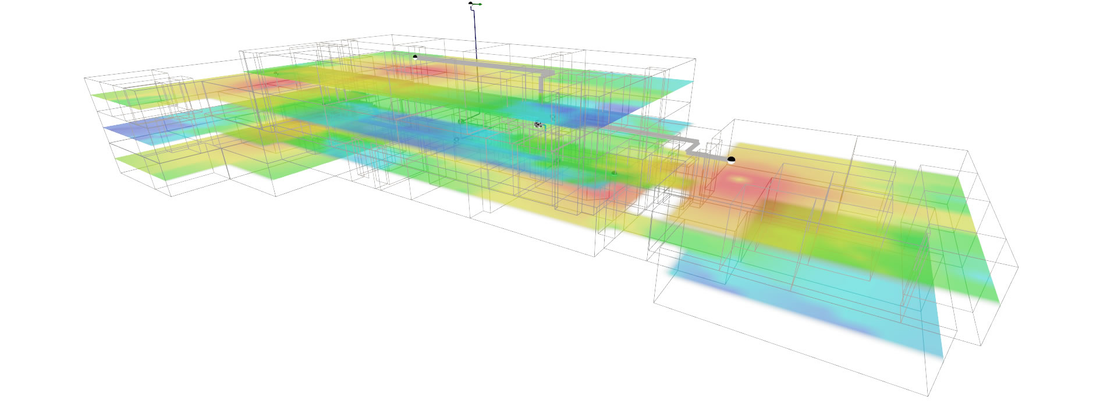The ability to communicate during an emergency is crucial for any first responder. To coordinate their response, they need to be able to transmit important information like their location and physical condition to their management location. National fire codes ensure that emergency personnel should have access to reliable radio transmissions. If a building fails to provide the mandated radio-frequency for that building than the building owners must install an Emergency Responder Radio Coverage System (ERRCS) to boost the specific local radio signal.
Also known as a Distributed Antenna System (DAS). These systems work to boost specific radio signals by using an outdoor antenna to take in the radio frequency. It then feeds it into the compromised areas of the building. An ERRCS is a DAS but specifically for public safety frequencies. Distributed Antenna Systems can also be used to boost cellular coverage which can facilitate in the safety of the building by eliminating dead zones. Areas that are usually affected by compromised radio coverage due to concrete, steel beams and other building materials are basements, stairwells, thick walled or shielded areas and rooms with Low-E glass windows. Just like we want to have good cellular coverage in a building, first responders want to have good coverage as well.
How the components of an DAS/ERRCS operate.

While national code sets the standards for Emergency Responder Radio Communication Systems, it is up to the local authorities to enforce and test these guidelines. Having these decisions left to the local AHJs leaves a lot of uncertainties for building owners and contractors who are questioning the requirements. These requirements change from jurisdiction to jurisdiction, but we are seeing more areas picking up the national standard every day. With urbanization and growth, radio frequencies have a harder time penetrating areas that need coverage. As your city grows and more buildings are constructed the radio frequency will become weaker and weaker. Unless there is appropriate equipment enhancing those signals, radio coverage will be harder to acquire. It is important to understand that radio frequency landscapes change. Your building may have adequate coverage now but that may not be the case in the future. A DAS/ERRCS will allow you to be better prepared for that possibility.
How a ERRCS/DAS is incorporated into a build.
Many questions that we get asked by contractors and building owners are: Do I need to test my building? If so, when should we test? Who determines if the building passes or fails? How long does it take to have a working system? How much does a system cost? Below we have highlighted the process and what steps to take when determining if an Emergency Responder Radio Communication System is required on your build.

Rough in and Test, a solution for that building you are unsure about.
Some buildings make it easy to know that a DAS will need to be installed. Other buildings can be tricky and are hard to verify if they will need a system before construction is done. Outside surroundings can have an effect as well since trees and other buildings can block signals too. There are many options to consider when it comes to installation. It is important to install a DAS/ERRCS in the earlier stages of construction before walls are buttoned up and ceiling panels are in. At that time though a signal test can still show the building as passing. As more materials are added to the build it could change the frequency coverage and before you know it your building is no longer passing, and construction is almost done. This can add a huge cost to the project as well as delay it significantly. Doing a rough in and test allows us to put in the cable assemblies and get the inner workings installed without the need to purchase the full system. We then test later in the project to verify the need which will provide a more accurate test. This is a great solution for those buildings that are just barely passing or could require a system in the future. With just a portion of the cost you can prepare your building for when a full system will need to be installed.
ERRCS/DAS equipment can be an expensive part of the project.
The most expensive part of these systems is the Bi-directional amplifier/headend equipment. With a rough in and test this equipment is not purchased until you need it. It can be easily installed if the cable assemblies are already installed as well. This solution makes projects operate more smoothly and allows our crew to be on site at the optimal time during construction. We have found this to be the best way to prepare for an ERRCS. No matter what stage your project is in we are always happy to talk with you to find out the best solution for your build. With radio frequency no project is the same and each building operates in its own manner. We understand those frequencies and will work with you to find the best solution for your project.
Clearline Engineering knows frequencies.
These systems bring communication and safety to our communities and public spaces. They were specifically created to help in emergencies and have become such an important feature to our infrastructure. It is an unseen, unrealized necessity. Clearline Engineering understands these systems and the requirements that go along with it. We can provide you with quotes that are specifically customized to your jurisdictions code adoption as well as assist with any specification that needs an experienced industry leader input. We can provide you with everything you need for the industry. Contact us if you would like to learn more.

